How to Build an NFT Marketplace and Ride the Wave of Non-fungible Tokens' Popularity
Updated 10 Jun 2023
17 Min
1360 Views
Decentralization is becoming a new and strong digital trend. As blockchain technology increasingly fills all areas of life, there is a growing interest in technologies such as decentralized finance (DeFi), cryptocurrencies, and Non-Fungible Tokens (NFTs). Building NFT marketplace app today is a great way to keep up with the trends and swoop into this industry before the competition gets too much.
This article will explain for you what NFT technology is, unveil essential features of NFT marketplaces, examples of successful platforms, and, most importantly, a step-by-step guide on how to make your own NFT marketplace.
What Is NFT Marketplace And How Does It Work?
And so, before we delve into developing an NFT marketplace, let's dwell on some details on this theme. NFT is a cryptocurrency trend that combines art and high technology. The idea of a Non-Fungible Token (NFT) is closely connected to blockchain technology. Also, the NFT is standardized, utilizing mainly the ERC-721 standard. Ownership rights in NFTs are specified in smart contracts, allowing buying, owning, and selling, but not granting exclusive rights to the digitized art. Key characteristics of NFTs include originality, integrity, and authenticity, making NFTs unique digital assets.
The NFT Marketplace is a dedicated trading platform explicitly designed for non-fungible tokens. Users can buy, sell, store, and exchange them on it. Most commonly, trading is carried out for cryptocurrency. It is often Ethereum (ETH), but some marketplaces can accept Bitcoin (BTC), other types of cryptocurrencies, and stablecoins for payment.
Users can buy and sell NFTs similarly on Amazon or any other marketplace. Some NFTs can be bought immediately, so you only need to click on the appropriate button and pay for the purchase. In other cases, you will have to “fight” at the auction on the NFT market.
Marketplaces may be divided into two types by offered product:
All-purpose NFT marketplaces
Platform which sell all sorts of tokens, from images about audio or even domain names.
Niche sites
Marketplaces that are narrowly concentrated and deliver only certain NFT collections, such as solely game skins or gifs.
According to the degree of restrictions on the placement of tokens, there are two types:
- Open. Every platform user can put their token.
- Closed. Only particular NFT creators (usually the project team) have the right to allocate tokens.
So how do these NFT marketplaces work? First, they operate smart contract technology for secure token transfer. Furthermore, marketplace apps utilize the unique NFT metadata of each element, such as origin and authenticity information. This information is secured by blockchain technology. Likewise, the token protocol is needed when you build an NFT marketplace platform.
How to buy tokens via NFT marketplace?
Today many platforms for NFTs' generating, selling, or buying are created. Some specialize in specific objects, such as selling game items, while others deliver any of the existing token types. Let's analyze the purchasing procedure stepwise:
First, it's essential to get a crypto wallet. It comes in handy both for registration in various marketplaces and for payment.
Next, choose a marketplace that seems suitable to you and register in it. When choosing, pay attention to the assortment, commissions, and payment methods.
To purchase NFTs, most often you first need to purchase Ethereum or any other cryptocurrency. Since most NFTs are based on the Ethereum blockchain, almost all marketplaces accept ETH as payment.
Finally, purchasing a token is truly easy. Most marketplaces have an auction format, so you need to apply for the NFT for sale you'd like to get and wait for the owner to respond.
Let's say a few words about custom NFT marketplace development. To create such platforms, you choose from two options: you can build an NFT marketplace from scratch or buy a ready-made script and modify it to fit your needs. However, for developing an NFT marketplace of good quality, it is still recommended to build an NFT trading platform from scratch.
Essential Points to Consider When Creating an NFT Marketplace
NFT is a reasonably new technology, so if you are seriously thinking about how to create an NFT marketplace, you should study specific technical details of this topic.
Create detailed NFT platform development plan
Although the custom NFT marketplace development process is quite complicated, there are things you can do, so you should carefully consider the process details:
- Determine the niche in which you will start your online marketplace development(particularly an NFT one). You can focus on works of art, make an NFT marketplace like an online game, or a video-on-demand platform.
- Choose an NFT marketplace developer company. Since making an NFT marketplace is quite a complex process, you need a team of experienced professionals in different industries. Pay attention to outsourcing companies, as they will allow you to get a qualified team without wasting time searching for each specialist separately.
- Together with designers, define UI/UX design for the future platform. High-quality design is an important part of building an NFT marketplace, so this point should be given special attention.
- Monitor the creation of the NFT marketplace at the stage of frontend and backend development.
- After all the technical tests and when all the possible bugs are fixed, get ready to launch your NFT marketplace.
- Deploy, enjoy your own NFT marketplace, and don’t forget to update and evolve it.
Below we will take a closer look at the development steps, and now we need to pay attention to the specifics of NFT marketplaces:
Implement smart contracts
If you desire to create your own NFT marketplace, you will need to implement smart contracts technology into the platform since it guarantees safe token trading.
A smart contract as a software (computer) code implemented on a blockchain platform, makes it achievable to ensure the self-execution and autonomy of the terms of the concluded contract in the event of the conditions and circumstances formerly specified in it.
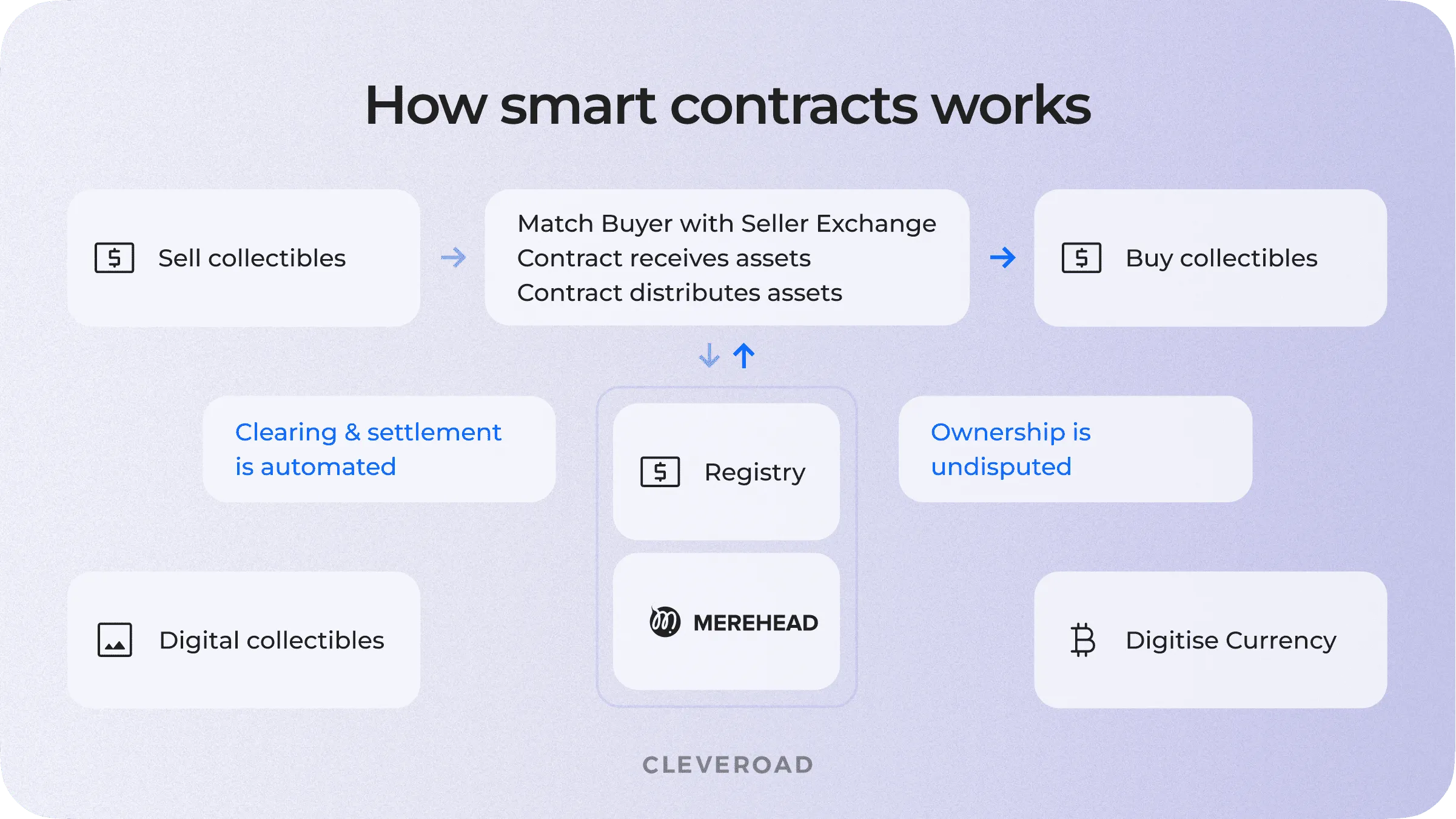
How a smart contract works
So the smart contract is one of the primary features when you create a NFT marketplace, and is worth paying special attention.
Get ready to employ blockchain technology
The use of blockchain in the NFT provides many benefits when you create NFT marketplace. Blockchain, which underlies the operation of NFT platforms, provides trading with many advantages:
- Transparency. The blockchain network guarantees complete transparency of all payments and allows users to see all transactions.
- Safety. When you build your own NFT marketplace, you have to pay special attention to security issues. You must guarantee users the complete protection of all transactions and the safety of their tokens. Blockchain enables us to notice and cancel any suspicious operation immediately.
- Decentralization. Information will not be accumulated centrally and therefore the operation and data storage becomes flexible. Instead, all critical data will be held in the blockchain, updated every time a new block appears.
What Functionality Should Be Included in Your NFT Marketplace?
When you create an NFT marketplace, it is vital to recognize that it combines an online store, an auction, and a blockchain platform. Many also offer extra features to stand out from the competition and motivate users to choose their offer. However, to build NFT marketplace from scratch, you always need an initial primary set of features that will let users make and exchange their NFT products. First, let’s discover which core features are necessary for any NFT marketplace:
Signup
Viewing lots can be available without registration. However, the future customer has to log in to use the main marketplace processes, such as buying and selling. Building an NFT marketplace generally involves signup methods such as email, social networks, and phone numbers. You may also use cryptocurrency wallets for registration.
Catalog
The base, without which no marketplace can exist. The user needs to find all the required information about the NFT, such as title, cost, payment method, owner, rating, etc. You can even provide data about the blockchain and protocol of the token, as this will increase user trust.
Search tool
Exploring a particular lot should be manageable. Filters and categorization will significantly simplify the search process and improve customer satisfaction with the platform's use.
Asset creation
Uploading a token and entering all the essential details, such as price, characteristics, tags, etc., should be easy. The process shouldn't take long. For illustration, you may consider the examples of successful marketplaces to find inspiration for your own collection manager.
NFT wallet
A wallet is vital to keep and move assets which are NFTs and cryptocurrencies. In order not to delve into building a new one, it is simpler to integrate any widespread crypto wallet, such as Metamask or WalletConnect, and a vendor with expertise in DeFi will help you with it. The only requirement is that it must support the NFT protocol you use.
Except for these ones, there are some features that can highly increase clients satisfaction:
Reviews and ratings
Any marketplace requires features that will allow you to evaluate sellers and the goods they offer. The rating system can be executed as a score or stars/likes. Reviews are most often implemented as comments that all users can see.
Notifications
A valuable component that will improve user experience. Push notifications about changes in the status of selected products, platform updates, new rates, actions with the user's product, etc., are essential and valuable features.
Support
Every quality marketplace has to include this feature. Users need to find out the answer to any question they have, settle conflicts, and solve technical problems. Interaction with the support service can be performed using a chatbot, call center, or email.
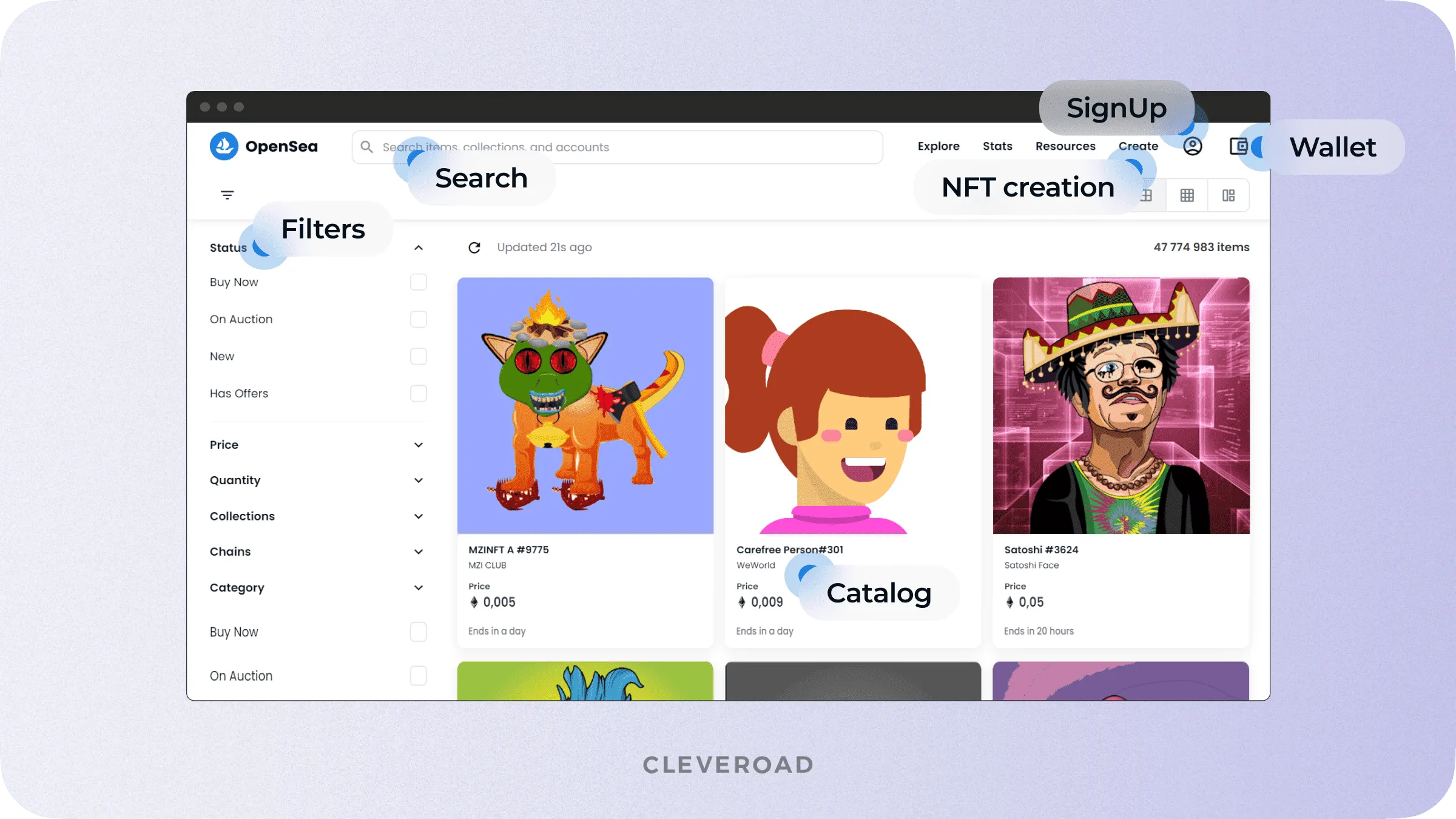
Some essential features on the example of OpenSea
How to Make an NFT Marketplace in 6 Steps
If you are wondering how to develop NFT marketplace, you should understand the basic creation process. It happens in several steps, and we will consider each of them on the example of our Software Development Life Cycle (SDLC):
Step 1. First contact
Once you submit a request on our website, it is directed to our Business Development Department. Within 24 hours, a dedicated manager with expertise in the NFT and blockchain domain will reach out to you to move forward with the process. To ensure confidentiality, we are ready to sign a Non-Disclosure Agreement (NDA) upon request.
Step 2. Solution Workshop
The Solution Workshop stage is designed to align your business needs with the technical implementation of your NFT marketplace. During this free phase, we listen to your challenges and tailor our IT solutions accordingly. Our dedicated Solution Team, certified business analysts, experienced solution architects, and creative designers will work with you to understand your requirements, clarify expectations, define the functional scope, suggest tech solutions, and estimate efforts.
We also consider constraints like development timelines, budget limits, and collaboration preferences. At the end of this phase, we deliver a comprehensive proposal that includes a value stream diagram, high-level feature list, architecture diagram, software architecture document (SAD), team composition, tech stack, sprint-based estimations, development costs, and relevant project examples. This ensures your NFT marketplace is precisely designed to meet your business objectives.
Step 3. Discovery Phase
During the Discovery Phase, we collaborate closely with you to define precise requirements for your NFT marketplace. This includes design, functionality, technology stack, and monetization models. Our team pays special attention to UI/UX design services, ensuring the perfect interface that meets all your needs. A well-designed NFT marketplace is essential for attracting and retaining users.
Our Discovery Phase services transform project requirements into a clear plan, speeding up development and improving product quality. We specify your business processes, detail requirements, and refine system architecture. Our team creates a detailed feature list, analyzes business processes, conducts quality attributes analysis, and crafts a design concept and UX map. By focusing on the Discovery Phase, we lay the foundation for a successful NFT marketplace that meets your business goals and user needs.
Stage 4. Development and integrations
At this stage, developers focus on creating a fully functional NFT marketplace. This involves both front-end and back-end development using the selected technical stack. Frontend development ensures a user-friendly interface with responsive design and smooth user interactions, typically using technologies such as React, Angular, or Vue.js.
Backend NFT development involves integrating blockchain technology and implementing smart contracts using platforms like Ethereum and frameworks like Truffle or Hardhat. This includes developing APIs and services to facilitate NFTs' creation, transfer, and verification. Additionally, integrating cryptocurrency wallets like MetaMask, Trust Wallet, or Coinbase Wallet enables secure transactions and user authentication. By combining robust frontend and backend development, developers create a seamless and secure NFT marketplace ready for user engagement.
Learn more details about our Fintech Blockchain Software Development services to get insights about how we can help you with your NFT marketplace project
Stage 5. Quality Assurance
Each stage of NFT marketplace development involves extensive manual and automatic testing to ensure the platform's functionality, usability, and security. Manual testing checks the user interface and experience, while automatic testing simulates various scenarios to detect hidden bugs and performance issues. This comprehensive approach allows developers to identify and fix potential problems early, ensuring the final product is robust, secure, and fully functional by the time of release.
Stage 6. Product release and maintenance
After all, the tests are finished, you can look at the resulting product again to ensure that you are happy with everything and do not want to add something extra. Then, you can launch an NFT marketplace to a broad audience. However, the field of NFT and decentralized finance is now actively developing. Therefore, after the product has already been launched, it is vital to continue its technical support and update it in time to stay ahead of the competition.
So, you have learned the main attributes of how to build NFT marketplace. Next, let's look at an example of their application in practice.
NFT Marketplaces' Success Stories
There is a comprehensive variety of NFT marketplaces. Each has its peculiarities that make them stand out from the crowd. So before you start to build NFT marketplace, let's examine the most favored ones.
OpenSea
The site is one of the most well-known today. Founded in 2017, it suggests all kinds of NFTs, like images, audio/video objects, etc. The OpenSea protocol operates NFT tokens of the ERC721 and ERC1155 standards (for collections). You can use any ERC20 standard tokens for paying. The marketplace supports Ethereum, Polygon, Klatyn, and Solana and works on compatibility with Flow. The platform commission is 2.5% when selling NFT and this is the major monetization model of this site.
Nifty Gateway
This platform focuses not on the number of tokens, but their quality and mainly sells the creations of famous artists. NFTs on the marketplace are named nifties, consonant with the marketplace's name. A feature of the site is that it supports transactions using fiat money, currencies already familiar to us. For the purchase of NFT, the marketplace withholds a commission of 5% and pays 10% from each subsequent transaction to the token's author.
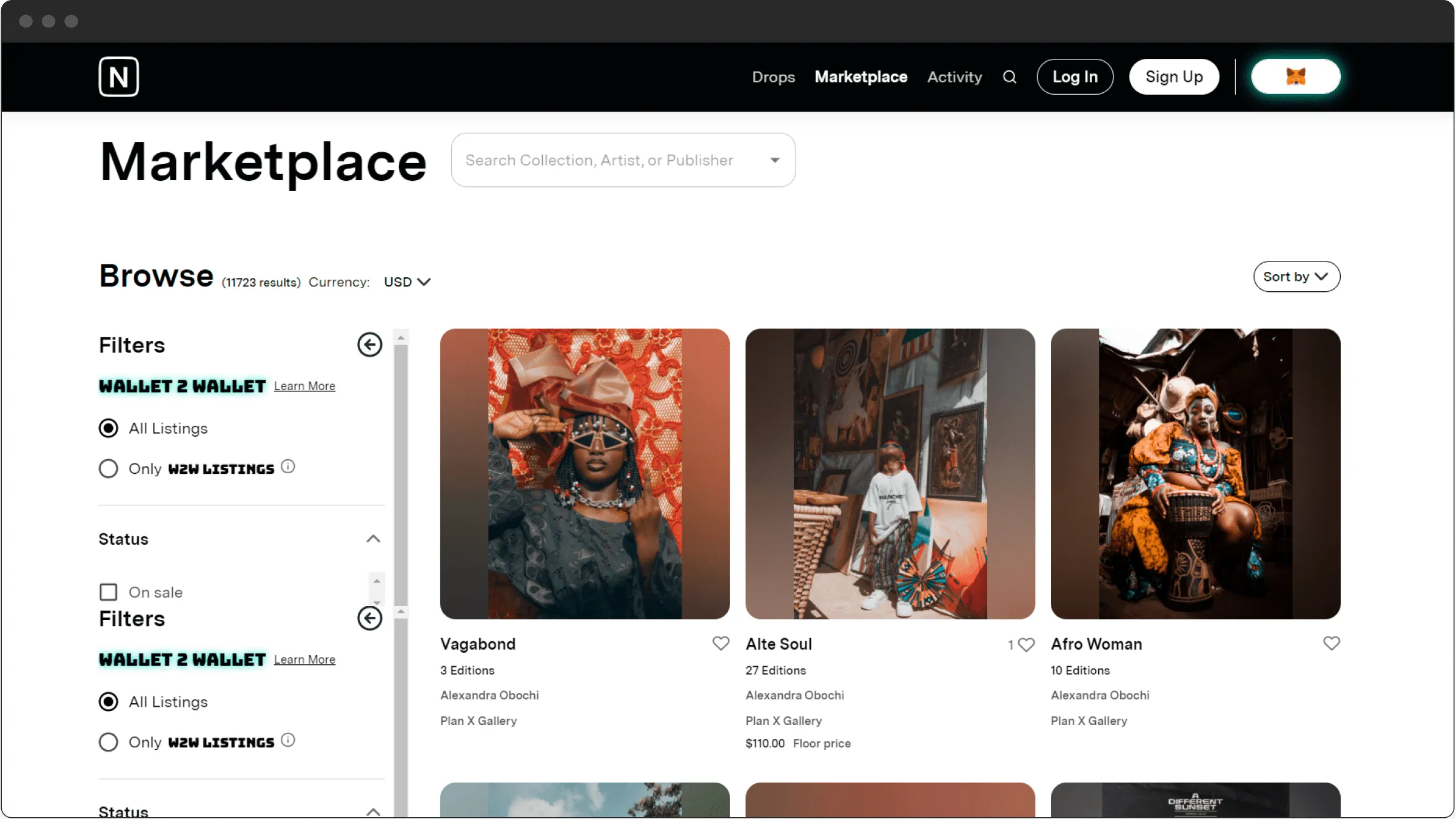
Nifty Gateway interface
SuperRare
The concept of the site is reflected in its name, which demonstrates that it allows you to purchase unique NFTs released in a single copy by eminent artists. Another feature of SuperRare is that it combines a marketplace and a social network where you can observe the artist's activities. However, the platform's commission is relatively high and involves 3% per transaction, 15% from the buyer, and 10% royalties for the author on each resale.
NBA Top Shot
An illustration of a very narrowly focused marketplace. Its target audience is basketball connoisseurs. They are offered video cuts with highlights from past games. The value of each NFT depends on its uniqueness. Likewise, NBA Top Shot runs on the Flow blockchain and charges a 5% commission on every transaction.
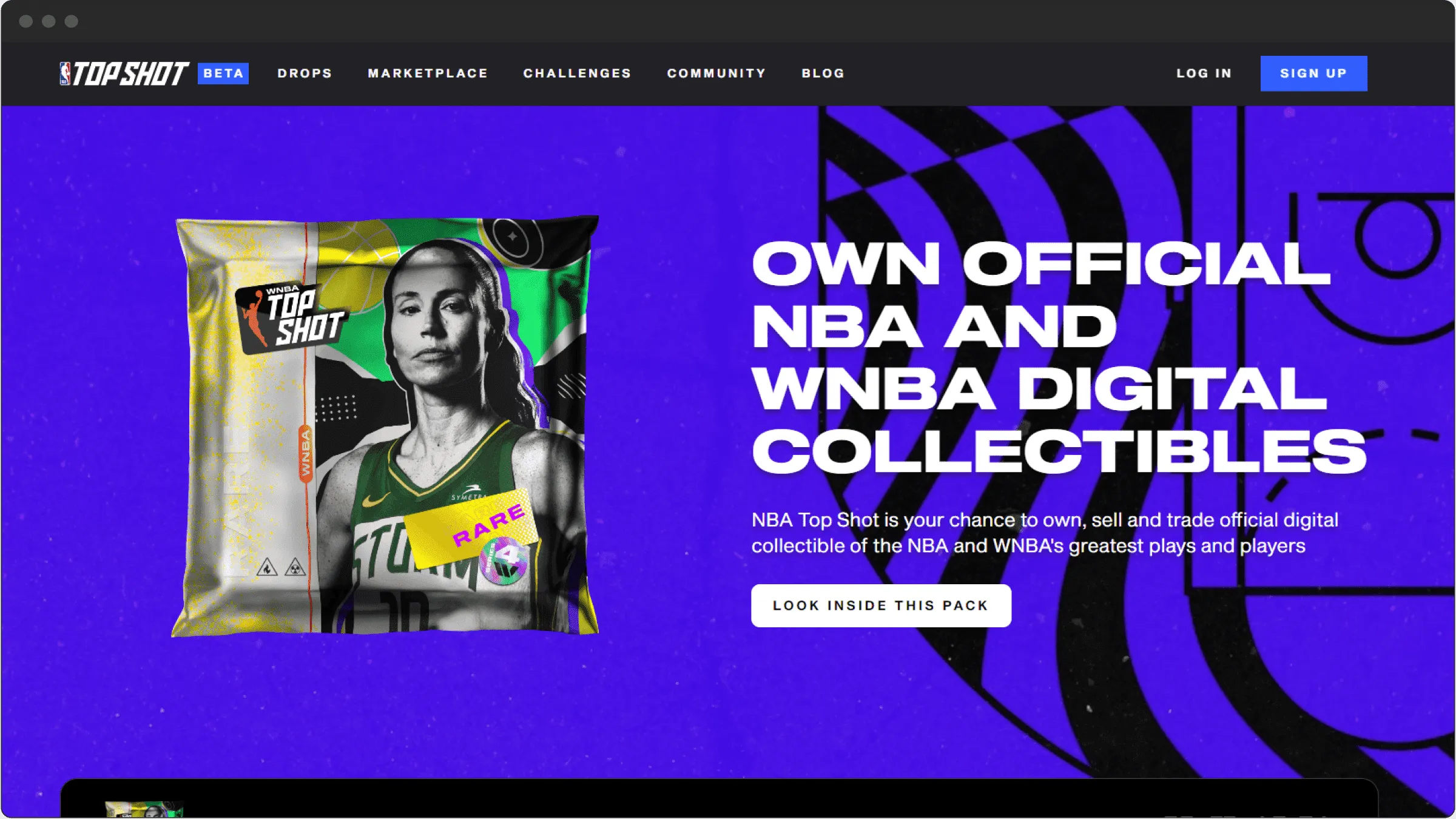
NBA Top Shot
Axie Infinity
Quite an unusual NFT marketplace in the form of an online game. NFTs presented on the platform are cute little animals, the so-called Axie. They can be purchased, grown, developed, and marketed to other users. The site also allows users to earn in-game currency AXS by winning battles and exchanging it for real money. This marketplace's popularity is increasing as it attracts users with exciting gameplay and unique NFTs.
Technology Stack to Build an NFT Marketplace from Scratch
Understanding the fundamental technologies used in creating an NFT marketplace is crucial to ensure success. In this section, we'll explore the key components of the technological stack required to build an NFT marketplace from scratch.
Blockchain foundation
So, to build a NFT marketplace, first, you should consult with your software provider to pick a blockchain platform. The following options are currently in use:
- Ethereum — is hugely widespread among NFT marketplaces, mainly because of its stability and visible transaction history.
- Flow — a new faster generation of blockchain widely used for creating the NFT marketplace and the tokens.
- Tezos — an open-source blockchain platform that lets you create marketplaces and assets for sale.
- Cardano — a blockchain platform that is exceptionally secure and resilient due to the most delinquent technologies and tools.
Storage solutions
Storage platforms are another important technical component. To make NFT marketplace, you can employ the following options:
- IPFS — a peer-to-peer hypermedia protocol that can store media content in a decentralized manner.
- Filecoin — a decentralized storage network created to keep any important information, including media files.
- Pinata — another popular platform for uploading and managing files in IPFS.
Front-end tech stack
When developing an NFT marketplace, selecting the appropriate front-end technology stack is crucial for ensuring a seamless user experience. Here are some commonly used front-end technologies:
- React.js — Offers flexible and high-performance UI development.
- Vue.js — Provides simplicity and scalability for dynamic front-end experiences.
- Angular — Offers robust features for large-scale application development.
- Web3.js — Essential for blockchain interaction, enabling wallet integration and smart contract interactions.
- Bootstrap or Tailwind CSS — Streamlines UI development with pre-designed components and responsive design.
Explore our guide on web development stacks to learn more about frontend technologies fir your NFT marketplace creation
Non-fungible token standard
The choice of standards, which we talked about earlier, is also very important. Here's what you can use:
- ERC721. The very first and classic standard for an NFT token on Ethereum. Each token has its smart contract and a unique ID. As well as complete uniqueness, the standard also ensures the flexibility of transferring NFTs between accounts and the ease of determining the owner of an asset.
- ERC1155. This standard is much more efficient than the forenamed one. It allows the opportunity of batch transfers - it can cover several assets with one smart contract, thereby ensuring their transfer with limited network load and lower transaction costs. It also has a "secure transfer" feature that allows you to cancel the transaction in case of an error.
- BEP. This is the standard for publishing tokens on the Binance Chain protocol, which is approved in this well-known ecosystem. Tokens of this standard function interact with each other, similar to tokens on the Ethereum network. BEP-2 support was implemented on the Binance DeX exchange deployed on the Binance Chain.
Your software vendor will tell you what to choose for your particular platform. In general, in the case of NFTs, competent expertise is especially important: this is a rather unexplored "land", and it is worth choosing a company that has already worked with NFTs in practice.
Cleveroad’s Experience in Developing an NFT Marketplace
Cleveroad is a professional software development company founded in 2011. We have launched more than 190 successful projects in various areas, e.g., FinTech. Cleveroad team comprises over 250 professional software engineers with significant background in the mobile and web development, including media industry and DeFi.
We will present how we created the VOD Platform for NFT Artists, Fans, and Buyers on the example of a solution we’ve made for Cere Network.
An American company from San Francisco, California, set the task for Cleveroad. The main area of activity of the client is high-tech B2C services, in particular decentralized data and finance (DeFi). The NFT platform should allow Cere to expand its area of presence and therefore the customer turned to us to make him a separate marketplace for trading these assets.
To solve this task, our developers created a web platform that could unite the target audience with the help of a video-on-demand solution. In addition, the newly designed NFT marketplace was integrated with Cere Network's decentralized data cloud (DDC) and Freeport CRM (solution for NFT merchants). Finally, our client also needed to implement a payment gateway to support payments with both fiat currencies and cryptocurrency, so we integrated it.
As a result, the client received:
- Innovative platform allowing operations with NFT media assets
- Development of direct relationships between content producers and consumers
- Full interaction with the existing DDC Platform
- Revenue stream from the new monetization model
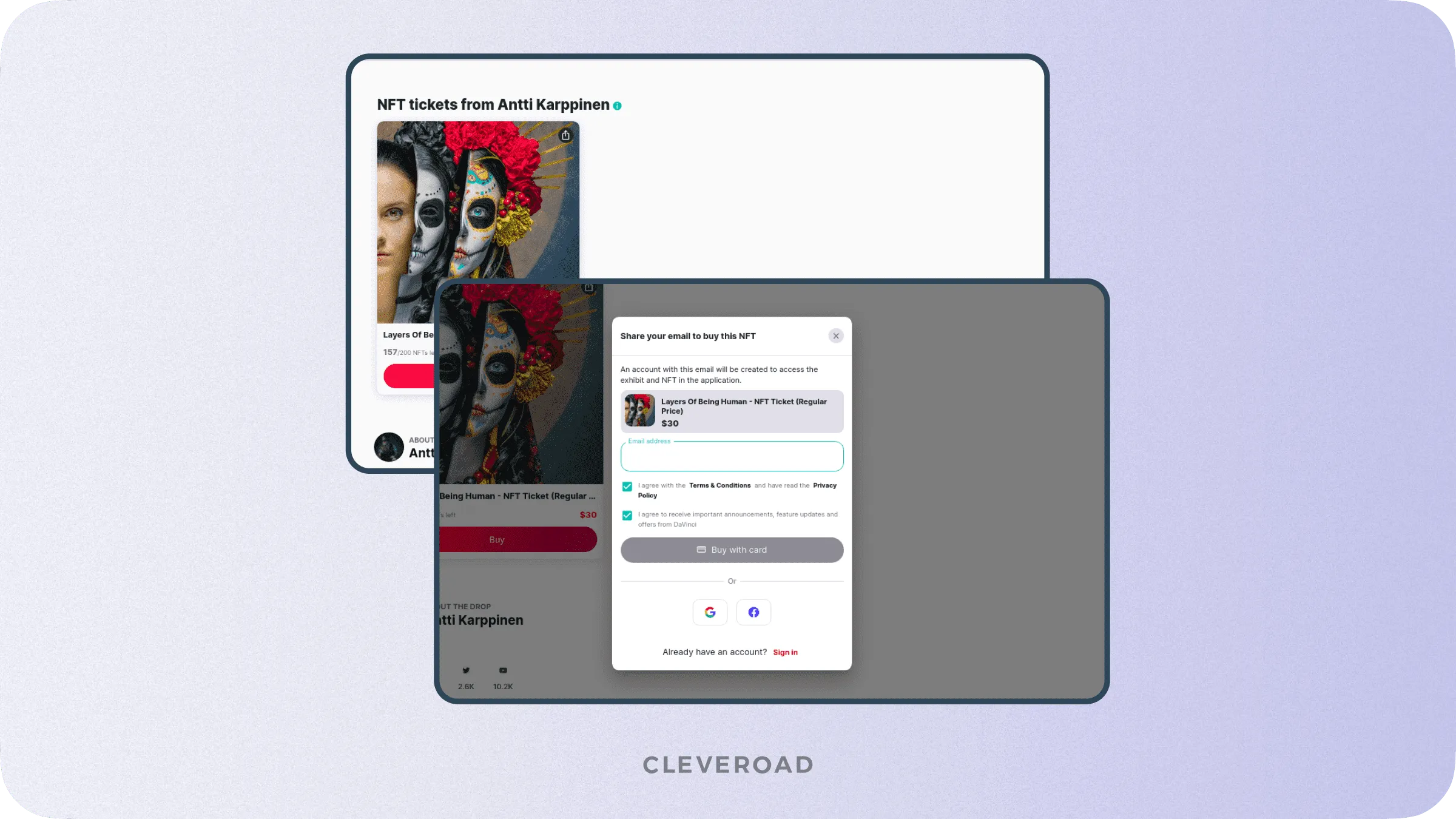
Cere Network NFT marketplace
By cooperating with Cleveroad, our client get such benefits:
- Free Solution Workshop Stage to match your NFT marketplace vision with technical implementation
- Experience in Blockchain development for processes optimization, transactions cost reduction, and fraud-protection
- ISO 9001-certified quality management ensures your NFT marketplace meets the highest quality standards.
- ISO 27001-certified security management, based on established policies and processes, guarantees robust data security for your NFT marketplace.
- Expertise in smart contracts creation, assuring eliminated risk of corruption or human errors and self-executive assets distribution
- Experience in integrating crypto wallets, including Blockchain encryption, Crypto Exchange, NFT Exchange
- Flexible cooperation models to meet your NFT platform project needs: Dedicated Development Team, Staff Augmentation, Time & Material
Build NFT Martketplace with domain experts
Our team with 12+ years of Blockchain and FinTech software development experience is ready to create a unique NFT marketplace for you
The NFT Marketplace is a dedicated trading platform explicitly designed for non-fungible tokens. It gives the ability to buy, sell and store NFTs.
Step 1. Determine the niche in which you will be creating the NFT marketplace.
Step 2. Choose an NFT marketplace developer company.
Step 3. Together with designers, define UI/UX design for the future platform.
Step 4. Monitor the creation of the NFT marketplace at the stage of frontend and backend development.
Step 5. After all the technical tests, get ready to launch your NFT marketplace.
Step 6. Enjoy your own NFT marketplace.
To build NFT marketplace, you may use one of the following blockchain platforms: Ethereum, Flow, Tezos, or Cardano.
An NFT (Non-Fungible Token) is a unique digital asset that represents ownership of a specific item, such as art, music, or virtual goods, using blockchain technology. Unlike cryptocurrencies, NFTs are indivisible and cannot be exchanged on a one-to-one basis, making each token distinct and valuable in its own right.

Evgeniy Altynpara is a CTO and member of the Forbes Councils’ community of tech professionals. He is an expert in software development and technological entrepreneurship and has 10+years of experience in digital transformation consulting in Healthcare, FinTech, Supply Chain and Logistics
Give us your impressions about this article
Give us your impressions about this article